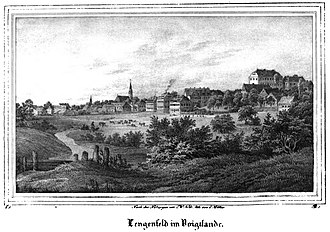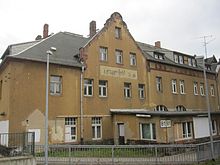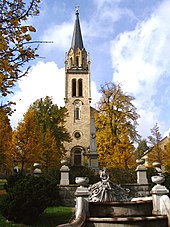Lengenfeld (Vogtland)
| coat of arms | Germany map | |
|---|---|---|

|
Coordinates: 50 ° 34 ' N , 12 ° 22' E |
|
| Basic data | ||
| State : | Saxony | |
| County : | Vogtland district | |
| Height : | 403 m above sea level NHN | |
| Area : | 46.98 km 2 | |
| Residents: | 7124 (Dec. 31, 2019) | |
| Population density : | 152 inhabitants per km 2 | |
| Postal code : | 08485 | |
| Area code : | 037606 | |
| License plate : | V, AE, OVL, PL, RC | |
| Community key : | 14 5 23 170 | |
| LOCODE : | DE ZAJ | |
| City structure: | Core city, 8 districts | |
City administration address : |
Hauptstrasse 1 08485 Lengenfeld |
|
| Website : | ||
| Mayor : | Volker Bachmann (Free Voters "Pro Lengenfeld") | |
| Location of the city of Lengenfeld in the Vogtland district | ||
Lengenfeld is a small town in the Saxon Vogtland district .
geography
Geographical location
The city is located in a side valley of the Göltzsch , about 20 km southwest of Zwickau and 20 km northeast of Plauen . It is located in the east of the Vogtland natural area and in the Saxon part of the historical Vogtland . The viewpoint "Pilz" offers with a height of 471 m above sea level. NHN a view of East Thuringia and the Vogtland Kuhberg near Netzschkau to the Erzgebirge Kuhberg near Schönheide , to the Steinberg , to the Goldene Höhe near Bad Reiboldsgrün and to the Kiel near Mühlleithen .
Neighboring communities
Neighboring communities are Heinsdorfergrund , Limbach , Reichenbach in the Vogtland , Rodewisch and Treuen in the Vogtlandkreis and Hirschfeld and Kirchberg (city) in the Zwickau district .
City structure
Lengenfeld is the core town of a large municipality with eight other formerly independent localities, today's districts Irfersgrün , Pechtelsgrün , Plohn / Abhorn , Grün , Schönbrunn , Waldkirchen , Weißensand and Wolfspfütz . Historic locations are New World and Pöhlwinkel .
history
12th to 18th centuries
Between 1150 and 1230, Lengenfeld was created as a Waldhufendorf by Franconian settlers . The first written mention of Lengenfeld dates from 1438 in connection with a donation from the Hoyersmühle (today's Klopfermühle ) to the Martin's altar in the parish church in Zwickau. A mayor was mentioned as early as 1419. The development from a village to a market town with urban rights also developed during this time. While the place was already referred to as a market in 1430 , it was only mentioned in 1764 as a “little town”. For the year 1471 Lengenfeld belonged to the Mylau rule . Conrad Metzsch on Mylau granted the place privileges and exemption from compulsory duties. Already in 1519, d. H. in the second year after the theses were posted in Wittenberg , the Reformation was introduced in Lengenfeld . In this context, there was a peasant camp in neighboring Waldkirchen during the Peasants' War in 1525.
Lengenfeld developed very quickly in the 16th century. The first schoolmaster is mentioned for 1541, the first town hall in 1544 and, after the separation from Kirchsprengel Treuen in 1545, an independent parish is mentioned. The founding of a cloth makers' guild in 1562 was a prerequisite for Lengenfeld's rise to an important textile location . 1633 was the blackest year in the city's history, when Lengenfeld felt the horrors of the Thirty Years' War and almost half of the population at that time, 233 people, died of the plague. During this time the neighboring Plohn Castle was also destroyed. In 1714, Lengenfeld received Reichenbach from Emperor Karl VI. the privilege to trade in cloth in Austria . In 1778 the weavers' guild was founded. With the establishment of the cotton factory, Lengenfeld's population almost doubled from 1150 to 2016 between 1779 and 1794. The cloth, felt cloth and white goods manufacture developed from the trade of cloth makers. Gottlob Friedrich Thomas set up the Vogtland's first cotton machine spinning mill with self-made spinning machines in 1806/1807. The city's first steam engine was installed in 1836/1837. In 1841 the last attempts at gold panning were made on the Göltzsch. In comparison, there were seven gold washes or soaps between Hoyersmühle and Mühlwand in 1730 .
19th century to the present
Lengenfeld came in the 16th century with the rule of Mylau to the Electoral Saxon or later royal Saxon office of Plauen , to which the place was subject until 1856. In 1856 Lengenfeld became the seat of the Lengenfeld court office . In 1875 the town was incorporated into the Auerbach administration .
In a major fire on May 10, 1856, the town center with its school, church and courthouse was destroyed. The city received its present appearance through the reconstruction. The Aegidius Church was completed in 1864 and the town hall in 1880. Since 1895 there was a post office in Lengenfeld. West of the neighboring town of Eich , with the opening of the Herlasgrün – Oelsnitz railway line in 1865, a train station was created which was initially named for the neighboring town of Lengenfeld, although it was only 500 meters away from Eich. Only after the city Lengenfeld in 1875 with the at the railway Zwickau-Falkenstein lie station Lengenfeld (Vogtl) received closer to the town station, the station was in the district of Eichmann in 1879 in Oak renamed. After the Lengenfeld – Göltzschtalbrücke railway line opened in 1905, the Lengenfeld (Vogtl) station received a new station building. This railway line, known as Mylische Berta, was in operation for the entire line until 1957/58 and up to Wolfspfütz until 1971.
After the city park was laid out in 1907, the first Lengenfeld Park Festival was celebrated in 1909. This event, which takes place every two years, is now one of the largest, oldest and most traditional folk festivals in the Vogtland.
From October 9, 1944 to April 13, 1945, there was a satellite camp of the Flossenbürg concentration camp near Lengenfeld with 1,000 prisoners from 11 countries who were forced to work in the Lengwerke , an armaments factory of the Junkers factories . 246 prisoners died during this time. The camp was evacuated before the American invasion of April 17, 1945, which led to acts of war.
As a result of the second district reform in the GDR , the city of Lengenfeld, like all of its current districts except Plohn / Abhorn, came from the Auerbach district in 1952 to the newly founded Reichenbach district in the Chemnitz district (renamed the Karl-Marx-Stadt district in 1953 ), which from 1990 as Saxon district Reichenbach was continued and in 1996 in the Vogtlandkreis. During the GDR era, the Hans Heinen children's holiday camp was operated in the village . Lengenfeld was the seat of the VEB Fluß- und Schwerspatbetrieb Lengenfeld , which belonged to the Kali combine .
With the fall of the Wall , the city experienced an economic upheaval with the closure of textile companies. An industrial park was built around 1990 on the "Grüner Höhe" in the northeast of the city. In 1993, a former industrial wasteland in the center of the city was expanded into the “Lengenfelder Hof” hotel complex with a business center.
The city of Lengenfeld has been a member of the planning association “Industrial and commercial area motorway junction Reichenbach / Vogtl.”, PIA for short, since 2009.
Incorporations
On April 1, 1935, the municipality of Grün was incorporated. The population rose suddenly by 1,400. Wolfspfütz followed on July 1, 1953, Plohn on July 1, 1993 with the village of Abhorn incorporated on January 1, 1979, Weißensand on January 1, 1994 and Irfersgrün and Pechtelsgrün on March 1, 1994. On January 1, 1999, Waldkirchen and Schönbrunn completed the series of incorporations.
Population development
Development of the population (from 1960 December 31) :
|
|
|
- Data source: Saxony State Statistical Office
1 Territory as of January 1, 1999
politics
City council
Since the municipal council election on May 26, 2019 , the 18 seats of the city council have been distributed among the individual groups as follows:
mayor
Volker Bachmann has been mayor since 2004. He was re-elected in June 2018.
Town twinning
The city of Lengenfeld has a partnership with the Czech city of Habartov .
coat of arms
Lengenfeld has had the city arms since around 1735. Blazon : in silver a nimbly bishop in red regalia, in his right hand a crook, in his left a parchment scroll with inscriptions; at his feet a gold shield with three black bars. The figure represents St. Aegidius , the patron saint of the town church.
Economy and Infrastructure
traffic
The A 72 motorway runs in the northeast of the municipality. The city of Lengenfeld is located on the Bundesstraße 94 , north of the Schönbrunn district, this joins the A 72 at junction 9 (Reichenbach). Lengenfeld has a train station and the Irfersgrün district has a stop on the Zwickau – Falkenstein railway line . Between 1905 and 1971 the Lengenfeld – Göltzschtalbrücke railway line with continuation to Reichenbach (until 1958) was in operation.
A citizens' bus with volunteer drivers has been running within Lengenfeld since March 2017 . For the time being, it runs every Monday, Tuesday and Thursday.
Establishments
During the GDR era, the Wolfspfütz district was home to the only factory for diesel injection nozzles for the IFA . The company still exists today as Monark Diesel GmbH .
Culture and sights
Building
- Church of St. Aegidius, neo-Romanesque, design by Christian Friedrich Arnold , organ by Jehmlich Orgelbau Dresden
- Replica of the Saxon postal mileage pillar on the market
Memorials
- Memorial from 1965 in the former wash barracks of the subcamp of the National Socialist concentration camp Flossenbürg on Walkmühlenweg to commemorate 246 victims of concentration camp imprisonment from different nations
- Mass grave and memorial stone from 1946 in the local cemetery for 57 prisoners of the subcamp, as well as memorial stone from 1994 for Italian military internees who died
- Street name in honor of the resistance fighter Felix Mauersberger from Netzschkau , who died on May 8, 1945 from the abuse he suffered in the subcamp
- Memorial stone in the middle of the Weißensand district for the victims of fascism . It commemorates nine female Jewish concentration camp prisoners who were murdered in the spring of 1945 on a death march from the Christianstadt satellite camp of the Groß-Rosen concentration camp
- Memorial stone for the fallen soldiers of the Franco-German War 1870/71 on the church square
- Memorial to the fallen soldiers of the First World War at the park
- Name of the fallen soldiers of the First World War in Lengenfeld in the entrance area of the St. Aegidius Church
- Memorial stone for the fallen soldiers of the First World War in Grün on Zwickauer Strasse
- Memorial stone for the fallen soldiers of the First World War in Plohn on Plohner Hauptstrasse
- Fritz Thomas memorial stone in the park
Museums
- City museum, housed in one of the oldest houses in the city with a plank room, barrel vault, arcade and completely preserved black kitchen.
- Fire brigade museum with old extinguishing devices such as the Opel Blitz tank tender from 1944 and the IFA S 4000-1 from 1967.
- The Klopfermühle is the last water-powered mill on the Göltzsch . It was first mentioned in a document in 1438. It can be visited and has a small museum.
Parks
The city park is the site of the Park Festival, one of the largest folk festivals in the Vogtland , every two years . The Plohn amusement park is located in the Plohn district , 500 meters from the former Plohn Castle , which later became the Plohn manor.
Sports
The Göltzschtal marathon takes place in Lengenfeld in October . In Germany it is the second oldest of all marathons that have been held since it was founded and the oldest in the former GDR . The organizing VfB Lengenfeld 1908 also runs the Göltzschtallauf as a half marathon in April .
Personalities
Honorary citizen
- Hermann Gerisch (1910–1994), teacher, local historian, dialect poet
- Gottlob Friedrich Thomas (1859–1921), councilor, felt cloth manufacturer, founder of the Lengenfeld Park
- Ernst Baumgärtel (1851–1939), councilor, important industrialist in the city
- Eduard Feustel (1874–1955), wool wholesaler, made a special contribution to the city hospital
- Wilhelm Bernhard Hildebrand (1825–1898), pastor in Lengenfeld
- Edwin Schubert (1893–1996), honorary citizen of today's district of Waldkirchen, local chronicler of Waldkirchen
sons and daughters of the town
- Johann Friedrich Ackermann (1726–1804), doctor and university professor, born in Waldkirchen
- Christian Gottlieb Hüttner (1787–1854), chief post director in the Saxon postal system
- Gottlob Friedrich Thomas (1755–1835), industrial pioneer and spinning mill owner
- Ernst Gottschald (1795–1871), Mayor of Plauen
- Konstantin von Tischendorf (1815–1874), theologian
- Otto Beutler (1853–1926), lawyer, Lord Mayor of Dresden, born in Waldkirchen
- Helmut Bechler (1898–1971), major general in the Wehrmacht in World War II, born in Grün
- Bernhard Bechler (1911–2002), Wehrmacht officer, after 1945 Minister of the Interior of the State of Brandenburg in the Soviet occupation zone , later with the National People's Army, born in Grün
- Carlordnung (1927–2012), publicist and politician (GDR CDU)
- Siegfried Stöckigt (1929–2012), pianist
- Michael Ketting (* 1950), engineer, top manager and professor for construction machinery technology
- Gunter Wild (* 1958), politician
People connected to the place
- Franz Adler (around 1814–1884), manor owner in Plohn and politician, MdL
- Joachim Dorfmüller (* 1938), lived and started school in Lengenfeld in 1944/45; Organist, pianist, music teacher, musicologist
literature
- Richard Steche : Lengenfeld. In: Descriptive representation of the older architectural and art monuments of the Kingdom of Saxony. 9th booklet: Auerbach District Authority . CC Meinhold, Dresden 1888, p. 8.
- The eastern Vogtland (= values of the German homeland . Volume 59). 1st edition. Verlag Hermann Böhlaus successor, Weimar 1998, ISBN 3-7400-0938-1 .
- Johannes Gündel: Families of Irfersgrün, after a card index in the estate of Johannes Gündel. Leipzig: German Central Office for Genealogy 1995.
Web links
- Lengenfeld in the Digital Historical Directory of Saxony
- Website of the city of Lengenfeld
Individual evidence
- ↑ Population of the Free State of Saxony by municipalities on December 31, 2019 ( help on this ).
- ↑ The "Pilz" lookout point on the city of Lengenfeld ( Memento of the original from August 10, 2017 in the Internet Archive ) Info: The archive link was automatically inserted and not yet checked. Please check the original and archive link according to the instructions and then remove this notice.
- ^ Karlheinz Blaschke , Uwe Ulrich Jäschke : Kursächsischer Ämteratlas. Leipzig 2009, ISBN 978-3-937386-14-0 ; P. 76 f.
- ^ The Auerbach administration in the municipality register 1900
- ↑ Website of the Flossenbürg Concentration Camp Memorial ( page no longer available , search in web archives ) Info: The link was automatically marked as defective. Please check the link according to the instructions and then remove this notice. Retrieved July 6, 2016
- ↑ ( https://www.reichenbach-vogtland.de/wirtschaft/planungs Zweckverband-pia / )
- ^ The Sachsenbuch, Kommunal-Verlag Sachsen KG, Dresden, 1943
- ↑ Federal Statistical Office (Ed.): Municipalities 1994 and their changes since 01.01.1948 in the new federal states . Metzler-Poeschel, Stuttgart 1995, ISBN 3-8246-0321-7 .
- ↑ StBA: Changes in the municipalities in Germany, see 1999
- ↑ [1]
- ^ City of Lengenfeld. Retrieved January 10, 2020 .
- ^ Heinz Göschel (Ed.): Lexicon cities and coats of arms of the GDR . 2nd, revised edition. VEB Bibliographisches Institut Leipzig, 1984, license number 433-130 / 98/84, p. 258 (order number 577 559 8).
- ↑ Vogtlandauskunft - Lines & Networks - Transport and Lines - Citizen Bus. (No longer available online.) Formerly in the original ; accessed on June 16, 2017 . ( Page no longer available , search in web archives ) Info: The link was automatically marked as defective. Please check the link according to the instructions and then remove this notice.
- ↑ Plauen online magazine: Vogtland citizens' bus association receives three minibuses - www.spitzenstadt.de. Retrieved June 16, 2017 .






